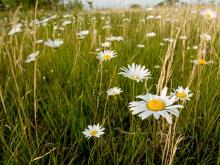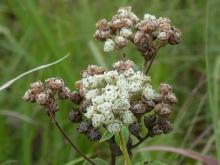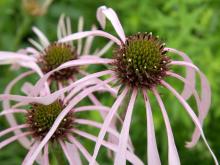Wildflowers, Grasses and Other Nonwoody Plants
Media

Species Types
Scientific Name
Centaurea stoebe
Description
Spotted knapweed is an invasive plant that outcompetes native communities, takes over pastureland, and even beats back invasive sericea lespedeza! It has arrived in our state. Let’s prevent its spread.
Media

Species Types
Scientific Name
Carduus nutans
Description
An invasive native of Eurasia that is spreading in Missouri, musk thistle is a plant you should know. Learn how to tell the difference between our native thistles and these bad guys.
Media

Species Types
Scientific Name
Pyrrhopappus carolinianus
Description
One of several native plants called dandelions, Carolina false dandelion is an annual with sulphur yellow flowers and puffy seedheads.
Media

Species Types
Scientific Name
Leucanthemum vulgare (formerly Chrysanthemum leucanthemum)
Description
Ox-eye daisy, though familiar, is not native to North America. It was introduced long ago from Eurasia. Common in grassy uplands, pastures, fencerows, and roadsides, it can colonize aggressively in the garden.
Media

Species Types
Scientific Name
Parthenium integrifolium
Description
A common component of high-quality upland prairie, American feverfew, or wild quinine, is a native wildflower that was used to treat fevers or malaria. It's in the composite family.
Media

Species Types
Scientific Name
Antennaria parlinii
Description
Plainleaf pussytoes, named for its fuzzy flower heads, is one of the few flowering plants in Missouri that grows well in dry and shaded areas. It’s also an indicator of acid soils.
Media

Species Types
Scientific Name
Echinacea pallida
Description
One of Missouri's five types of echinacea, pale purple coneflower is distinguished by its white pollen, drooping pink or purple ray flowers, and narrow, tapering leaves. It occurs nearly statewide, except for the Bootheel lowlands.
Media
Species Types
Scientific Name
Erigeron philadelphicus
Description
The antique belief that this plant might repel fleas gives the fleabanes their name. There are more than 170 fleabanes in the genus Erigeron in North America. This one is scattered to common nearly throughout Missouri. Native Americans used this species medicinally for a variety of ailments.
Media

Species Types
Scientific Name
Packera spp. (formerly Senecio spp.)
Description
Ragworts, or groundsels, have several common names, and separating the different species can be a little tricky. But members of genus Packera, with their bright yellow daisy-like flowers, are distinctive as a group. Seven species have been recorded in Missouri.
Media

Species Types
Scientific Name
Packera plattensis (formerly Senecio plattensis)
Description
Prairie ragwort is one of seven Packera species in our state. It grows in sunny, open habitats. Look for its clusters of bright yellow, daisylike flowers in May and June.
See Also
About Wildflowers, Grasses and Other Nonwoody Plants in Missouri
A very simple way of thinking about the green world is to divide the vascular plants into two groups: woody and nonwoody (or herbaceous). But this is an artificial division; many plant families include some species that are woody and some that are not. The diversity of nonwoody vascular plants is staggering! Think of all the ferns, grasses, sedges, lilies, peas, sunflowers, nightshades, milkweeds, mustards, mints, and mallows — weeds and wildflowers — and many more!





















